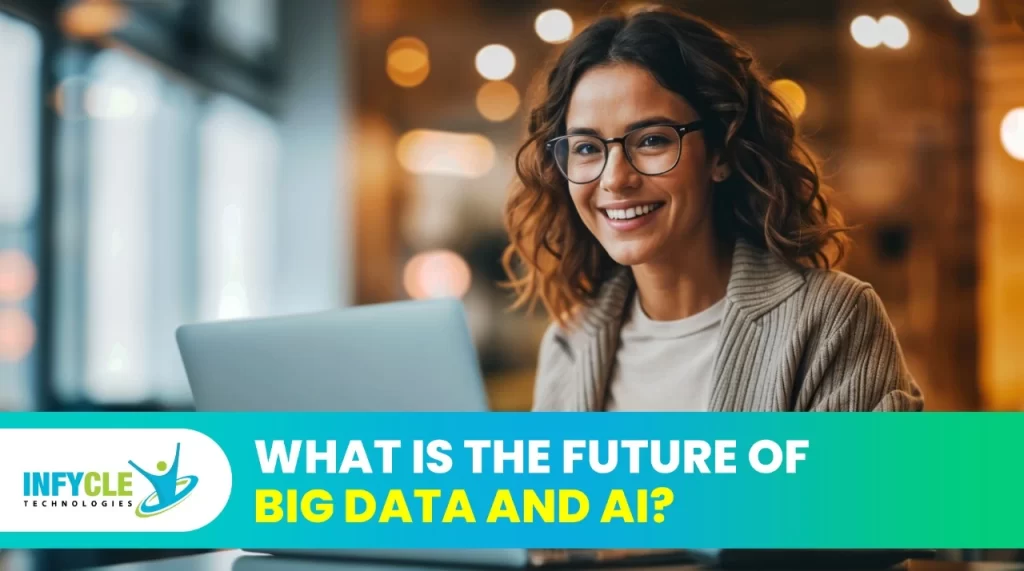What Is The Future Of Big Data And AI?
The era of Big Data and AI has transformed our world beyond our imaginations. It gives us possibilities that we could never have imagined. Collaboration between Big Data and AI has revolutionized industries, enabling remarkable feats.
Think about a scenario in which doctors can correctly diagnose patients and recommend specific therapies, or where you may shop online with preferences met. The power of AI & Big Data makes anything and everything possible.
Big Data and Artificial Intelligence seem to have no limits. As these technologies developed rapidly, we will surely be in awe of them. If you are someone who wants to kickstart or boost your career, AI and Big Data are optimal choices due to their growing significance. You can optimize your learning journey by enrolling in the Big Data Hadoop Training in Chennai.
In this blog, we will look at the future of Big Data and Artificial Intelligence, analyzing their future possibilities and the influence they are expected to have on many industries.
Understanding Big Data And Artificial Intelligence
Big Data is the term used to describe the enormous volume of data that is created and gathered from many sources, such as social media, computers, smartphones, sensors, etc. It involves vast amounts of data, both structured (organized) and unstructured (disorganized), that are frequently complex and varied. There are much more significant “Vs” of big data that organizations must address, including velocity, visualization, veracity, variety, validity, and value.
To learn more about these V’s, read our blog about What Are The 7 V’s Of Big Data.
The term artificial intelligence, or AI, describes the process of creating computer systems that are capable of carrying out operations that normally need human intelligence. (logic, decision-making, reasoning). It entails building computational models and algorithms that let computers evaluate, gain knowledge through data, and make decisions just like people do.
According to the Wheebox National Employability Test (WNET), as of August 2023, India has about 416,000 AI professionals, but the demand is around 629,000, and it’s expected to reach 1 million by 2026.
How Do AI And Big Data Work Together?
AI and big data complement each other quite well. It is big data that provides the enormous amounts of data needed to train AI algorithms and enable them to make precise predictions or decisions. Conversely, artificial intelligence (AI) enhances big data by automating data processing, gathering insightful information, and formulating predictions or suggestions. They have a strong symbiotic connection.
Big Data serves as the unprocessed data, and AI processes and examines it. With their combo, it can identify important patterns and insights that could be difficult for humans to find on their own. Big Data may be turned into actionable insights by applying AI algorithms, which also help organizations anticipate future trends and make well-informed decisions. The ability of AI to interpret Big Data enhances its ability to identify intricate relationships, irregularities, and correlations that might otherwise be missed.
Examples Of AI And Big Data
Big data and AI are being used in a multitude of ways by numerous organisations that have realised the potential of machine learning-enhanced big data analytics.
- Netflix employs artificial intelligence algorithms to comprehend each customer and provide more personalized suggestions. The above data keeps the consumer on the site for longer, resulting in a better overall customer experience.
- Google applies artificial intelligence to give people a highly valued and personalized experience. They apply machine learning to a range of products. It includes predictive language in emails and optimized instructions for users trying to get to a specific area.
- Starbucks is employing its “digital flywheel” with AI-enabled features to send out over 400,000 personalized weekly emails with various promotions and offers, rather than generating simply a few dozen emails monthly for general Starbucks customers.
Companies will keep utilising the power of artificial intelligence, big data, visualization tools, and analytics to assist their organizations make decisions based on raw data. Without big data, none of the above more personalized experiences would be feasible.
Emerging Trends In Big Data And AI
AI aims to develop devices that perform tasks normally completed by humans faster, more accurately, and more efficiently. AI and big data are quickly developing fields with constantly changing trends and breakthroughs. Among the most prominent new developments in AI and big data are the following:
Edge Computing:
Data is processed at the edge rather than at a central location. Its quicker processing time and real-time analysis of data make it ideal for applications such as autonomous vehicles, industrial IoT, and others that are time-sensitive.
AI-powered Internet Of Things:
As the IOT expands quickly, Artificial Intelligence (AI) is becoming more and more crucial to the efficiency of IoT systems. Enhancing the effectiveness and productivity of IoT systems is feasible through the application of AI algorithm. It can analyze data collected by IoT devices in real time and detect future patterns and developments.
Natural Language Processing (NLP):
A branch of artificial intelligence called natural language processing (NLP) is concerned with natural language communication between computers and people. Developments in Natural Language Processing (NLP) have widened the possibilities for the creation of artificial intelligence (AI) systems. It can comprehend and react to human speech and text, facilitating human-AI interaction and increasing accessibility.
Explainable AI (XAI):
Artificial intelligence (AI) systems that can describe their decision-making processes are referred to as explainable AI (XAI). XAI is a crucial tool in ensuring that AI systems are open and reliable. This will become more and more vital as AI is used more and more in the recent days.
Reinforcement Learning:
Reinforcement learning is a sort of machine learning that utilizes rewards and penalties to educate artificial intelligence systems. It allows AI systems to gain knowledge from their firsthand knowledge. And it make decisions based on user feedback, enabling the development of AI systems capable of operating in varied and complicated situations.
The recent rise in popularity of platforms such as ChatGPT is just one among numerous emerging developments related to Artificial Intelligence and big data. These technology advances, new trends, and breakthroughs are expected to emerge, revolutionizing the way organizations run and enriching our daily lives in new and fascinating ways.
Applications Of Big Data And AI
Big data and artificial intelligence have risen in popularity in recent years, with applications across a wide variety of industries. Some of the most significant applications of big data and AI in different sectors include:
Healthcare:
Healthcare employs big data and artificial intelligence (AI) to enhance patient outcomes and save expenses. For example, AI systems can analyze enormous volumes of medical data to detect patterns and anticipate disease outbreaks. This allows medical professionals to avoid and handle outbreaks in a better way. AI is also being used to produce personalized medicine, which involves tailoring therapies to someone’s particular requirements according to their genetic profile and past medical history.
Finance:
To enhance financial decision-making and lower fraud, the finance sector uses big data and AI. For instance, artificial intelligence (AI) systems may examine vast volumes of financial data to spot trends and predict fraudulent activity, assisting financial organizations in better preventing and controlling fraud. AI is also utilized in the creation of financial products like robo-advisors and personalized investment portfolios. This employ Big Data and AI to offer financial advice tailored to each user’s unique requirements and preferences.
Retail:
To enhance consumer experience and streamline operations, big data, and artificial intelligence are applied in the retail sector. Retailers can increase consumer engagement and offer more personalized suggestions by using AI algorithms. This may analyze vast volumes of customer data to find trends and forecast customer behavior. The supply chain management industry also utilizes AI. AI algorithms actively improve inventory management and distribution routes in those domains.
Manufacturing:
To enhance operational efficiency and boost product quality, the manufacturing sector uses AI and big data. For example, manufacturers can more efficiently prevent and handle equipment failure by using AI algorithms. At the same time, it can analyze vast volumes of production data to find patterns and forecast equipment failure. Companies utilize AI in quality control measurements. AI algorithms actively identify flaws in products in real-time and enhance their quality within these industries.
Conclusion
The integration of Big Data and AI has transformed sectors, revealing incredible opportunities and improvements. The combination of these technologies has the potential to revolutionize in the major industries. This includes medical care, manufacturing, vehicle autonomy, finance, energy, education, retail, and entertainment. As technology advances, the future holds enormous promise for Big Data and AI, with the incorporation of emerging trends further improving their power.
To learn more about the field of AI and Big Data, Infycle Technologies provides comprehensive courses to equip you with essential skills. Stay on top of your professional game by learning these advanced and innovative skills.





